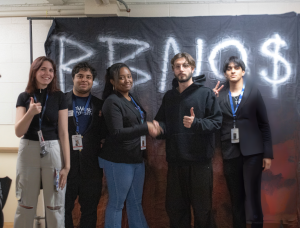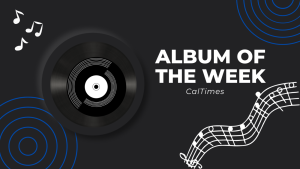America’s Most Dangerous Sport
December 5, 2017
Ever since the 1800s, Americans have been hooked on American football.
The first ever game was played at the college level between Rutgers and Princeton, but the National Football League wasn’t created until August 20, 1920, in Canton, Ohio.
Football has progressed over the years, with new teams, popular players making big splashes into the league, jerseys and equipment. Football has also regressed, in terms of injuries, specifically concussions.
While there are excellent physical trainers at the high school, collegiate and professional levels, no sports medicine or rehabilitation can speed up the healing of a concussion. For some players, the damage remains permanent.
Many studies are finding severe cases of CTE, or Chronic Traumatic Encephalopathy, in deceased football players – not just at the NFL level.
Recently, in July 2017, results from a concussion study published by the Journal of the American Medical Association, with Dr. Ann McKee leading the study, showed that 177 out of 202 brains had CTE. That number rounds out to 88 percent of CTE-found brains, in the study which was done at Boston University.
The study had counted players from the Canadian Football League, those who only played in high school, college players and semiprofessional players.
However, the drastic and jaw-dropping numbers came from the NFL players. Out of 111 deceased NFL player brains that were studied, 110 brains were diagnosed with CTE.
Dr. McKee spoke on the findings, saying that the study was “by far the largest study of individuals who developed CTE that has ever been described. And it only includes individuals who are exposed to head trauma by participation in football.”
The NFL followed up the study with a lengthy statement, saying that they appreciated the work by McKee and her colleagues.
“Case studies such as those compiled in this updated paper are important to further advancing the science and progress related to head trauma. The medical and scientific communities will benefit from this publication and the NFL will continue to work with a wide range of experts to improve the health of current and former NFL athletes. As noted by the authors, there are still many unanswered questions relating to the cause, incidence and prevalence of long-term effects of head trauma such as CTE. The NFL is committed to supporting scientific research into CTE and advancing progress in the prevention and treatment of head injuries,” the statement read.
The debate surrounding CTE rose over the summer when a severe case was found in the donated brain of Aaron Hernandez.
Hernandez was formerly a star wide receiver for the New England Patriots, and played collegiately at the University of Florida. However, his football career came to an abrupt end after he was arrested and charged with the murder of Odin Lloyd in 2013.
Hernandez was found guilty of first degree murder in 2015, and was acquitted for a 2012 double homicide. After, the verdict, Hernandez hung himself in his prison cell.
McKee, who led the research on Hernandez’ brain in the same study, wrote that he had “classic features” of CTE in his brain. A lawyer for the Hernandez family released a statement saying that the research provided “the most severe case they had ever seen in someone of Aaron’s age.”
Hernandez was 27-years-old when he died in April 2017.
With the rise of CTE and concussions being brought to life through studies and players voicing their opinions, there has been questioning of the sport. Should players be putting themselves at risk, and should parents sign their children up at such a young age? Are there kids playing football that have willingly played through concussions?
Isaiah Allums, a senior at Monessen High School in Pennsylvania, admits he doesn’t know if he’s had a concussion, because nothing has stopped him from playing football.
“They don’t really happen that often in my opinion,” Allums, a defensive end, said. “I’ve never had one and I’ve been playing all four years in high school.”
Allums explained that if a player were to sustain a concussion, the school’s athletic trainer would pull them aside and ask questions along the lines of where they go to school, what their birthday is and how old the students are.
Allums’ teammate, quarterback Cory Fleming, doesn’t feel the same way. Fleming explained that college coaches have taken a look at his games, and even introduced themselves after games this season. However, he doesn’t have plans to take his talents to college with him.
“I plan on having a good career, in whatever path I choose,” Fleming said. “I don’t think hurting my body, and my brain, through football can get me where I want to be. There’s other more important things I want to do with my life.”
In between the two, Austin McWilliams, a running back on the team, said that he loves football, but doesn’t know if he would risk his mental and physical health to continue in college. McWilliams noted that he had suffered one concussion through football, and a second while playing basketball.
“I love football, but I have bigger plans with my life,” McWilliams said. “I would actually like to go to college and not worry about my long-term health.”
At the college level, there is more to concussions than just being pulled aside on the sideline.
According to Dr. Jamie Weary, the head athletic trainer at California University of Pennsylvania, players are given a concussion fact sheet the first day they arrive at training camp. Weary said the sheet is explained through the players, and then the players sign an acknowledgement form about the sheet, “Before they even get the key to their room.”
Weary said that the checklist in important because many players don’t understand that there are more symptoms to concussions than just dizziness and headaches. Weary explained that other symptoms are trouble sleeping, trouble concentrating, sensitivity to light, sensitivity to sound, change in mood, change in personality and mental fogginess.
Weary said that she sees the most concussions in football and women’s soccer.
“It’s the contact nature of the sport, and it depends on what activity you’re doing,” Weary said.
She continued to explain that the NCAA has guidelines that if a player is to show any symptoms of a concussion they are removed “immediately” and withheld from participation for 24 hours.
“They have to be observed, evaluated and cleared by someone who knows how to evaluate concussions,” Weary said. “For us, that’s our athletic training staff because we’re all trained on how to manage, treat and deal concussions. If they are more severe cases, we’ll involve the team doctors. On the most severe cases, we’ll work with the UPMC concussion center.”
At Cal U, both Weary and Vulcan football Head Coach Gary Dunn reiterated that they do not have full contact practices. Instead, there are only two times an entire year that Dunn runs “live” drills: once in the spring and once in the fall.
“We try to practice as safe as we can,” Dunn, who just finished his second season as head coach, said. “We’re probably a little bit different than most schools; hardly ever do we tackle to the ground. We teach our guys at the beginning of every year that we try to take care of our teammates. If we have a receiver going across the middle and we could put a big shot on them at practice, we don’t do that. We lay off and we understand that we’re going to be safe.”
“We talk to our guys constantly about player safety.”
Dunn complimented the work of Weary and said that the policies, regarding concussions and player safety in general, Cal U implements are “really good.” However, Dunn recognizes that players who sign up for his program, and football in general, should expect that there is a risk.
Dunn also explained that when it comes to whether an athlete can practice or play he has no say, but that it comes from the team doctors and athletic trainers. Weary and fellow athletic trainer Mindy Fisher provide Dunn with a list of who can participate, no matter what injury they sustain, before every practice and game.
Concussions aren’t just about protocol should one happen to a player. Instead, Athletic Director at Cal U, Dr. Karen Hjerpe, wants to extend concussion education and awareness.
“At the start of the year, I tell each athlete in each program that they need to let us know if they have been hit and feel they could have a concussion,” Hjerpe said. “They need to take themselves out of practices and games. They need to report it immediately to a coach or athletic trainer and we take this very seriously. You would have to ask the athletic training staff in regards to protocol.”
Hjerpe also agreed that the sport with the highest concussions, that she has seen, is football and women’s soccer.
Meanwhile, Dunn claimed that he had read studies before that showed other sports with a higher concussion rate. Despite his own research, Dunn owned up to football having a concussion issue, but says the NFL is addressing it.
“Sometimes football gets a bad rap in terms of concussions, but I think we’re on the right track for doing things the right way,” Dunn said.
One of Dunn’s players that has ruled out potentially making a move to professional football is senior defensive end Corey Bopp.
Bopp said that concussions have been a “very serious” issue that many players are pretending doesn’t exist. He even gave football the title of being a “warrior” game.
“If you take hitting out of football, or make major changes to the way it is played, it compromises the integrity of the game,” Bopp explained. “By integrity, I mean what makes the game great. I think football should be looked at in a similar light to mixed martial arts or boxing; it’s not everybody and there is an inherent risk in participating.”
Bopp has plans to become a lawyer after he graduates from Cal U in the spring. He stated that he would “never” continue football after college and advised others to follow the same suit, unless “they are guaranteed a nice contract or have bleak career options after football.”
Football has been failing in popularity and view loyalty as well, and will continue to do so over the next 20 years, Bopp stated. He added that the NFL isn’t helping bring the popularity of the sport up, with rule changes that driving fans away.
Bopp stated that if he should have a son who wants to play football in the future, he wouldn’t let him until middle school, at the earliest. Even then, he said that his recommendation would be to play basketball or soccer instead.
“The years prior to middle and high school are when all of my head injuries occurred,” Bopp said. “I believe I had two concussions diagnosed and probably some that were due to my want to not leave the field. I don’t feel those early years were at all beneficial to my eventual scholarship offers or career.”
However, Cal U’s quarterback, Michael Keir, has a different opinion, stating he would continue his football career, should the offer come to fruition. Keir acknowledged that he has never had a concussion in his football career.
“Football is something that I love and I know exactly what I’m risking when I step on that field,” Keir said. “You can’t play the game worrying about injury. Most of the time when people play that way, they usually end up getting injured.”
Despite having no advance technology specifically meant for helmets – expect for the padding that already comes inside them – Keir said the NFL is making “huge strides to help prevent injuries.”
I think they had by make equipment better, teaching the correct way to tackle, changing rules of the game to help protect people and giving the athletic trainers full say if a player can play or not if they suspect any type of head injury,” Keir said.
When it comes to helmets, Weary said there’s not much the NFL can do to prevent head injuries. Helmets only come with padding, and even Weary said that protective headgear gives players a “false sense” of protection.
“Sometimes it can cause more than what it tries to prevent,” Weary explained. “So it comes down to the neck stabilization position, tackling techniques and such that comes down to the prevention side versus what you’re wearing on your head.”
Weary said it doesn’t matter what type of headgear a person wears; it’s the velocity and stop that causes concussions, not the impact.
“You equate your head to the brain as an egg,” she said. “Your skull is the egg and the brain is the yoke. If you hit it, the blunt force trauma, the helmet can hit it with a direct force, but it’s the abrupt stop that stops the blunt force, but does not stop the torque and the rotation that happens. It doesn’t matter about what head gear you’re wearing, it cannot stop all concussions.”
Weary commended the recognition of concussion awareness among parents and coaches. Back then, she explained, players would be told to “Suck it up” and “Get back in there.” Now, players, coaches and parents are taking the concussion protocols and issues in a serious manner.
However, she admitted that there’s not much the NFL can do to prevent concussions. Meanwhile, Dunn stated the same manner, but expressed that all coaches should be part of Heads Up Football.
“We’re making football as safe as we can for our student athletes,” Dunn said. “A lot of it is learning different ways to do things that maybe you didn’t do in the past.”
What more can truly be done then to help lower the number of CTE found in players’ brains? How else can football be made into a safer sport?
Fans aren’t going to watch flag football, and fans have already made their voices known with various rule changes. However, Dr. McKee said that there is a growing concern about players honing these injuries.
“Families don’t donate brains of their loved ones unless they’re concerned about the person,” McKee said. “We’re seeing this CTE in a very large number that participated in football for many years. So while we don’t know the exact risk and we don’t know the exact number, we know this is a problem in football.”
There is a call for more research, but that also requires funding. McKee said that in order to figure out the next step on preventing concussions is a “very well-constructed longitudinal study.”
“We need to follow them for decades,” she said. “We need to take measurements throughout their lives and playing careers so we can begin to detect when things start to go wrong. If we can detect early changes, that’s when we could really make a difference.”
No doctor is out to ruin the sport of football, but to make it safer. Hernandez wasn’t the only player who committed suicide, and whose death was connected to CTE and concussions. Junior Seau, Ken Stabler, Frank Gifford, Andre Waters, Ray Easterling and Dave Duerson are among other popular players to suffer the same similar fate.
It would be naïve for sports fans to think this is just a problem in football; many other sports provide concussions, especially hockey, rugby and soccer. McKee noted that it’s not just a football problem, but an issue that needs to be talked about – and studied – throughout other sports, as well.
“I think any sports organization that has participants that are exposed to head trauma needs to endorse this research and support it,” McKee stated.
However, finding 110 cases of CTE out of 111 players is astonishing, and a cause for concern among players, and the league. The league has expressed in their statement that they are “committed to supporting” research on concussions, head trauma and CTE.
Instead of sending more players to the protocol, the league must focus on preventing protocol from even happening. The NFL, Canadian Football League, college, high school and youth game must be made safer, or the consequences will be life-threatening.
This article was part of Rachael Kriger’s senior project, where the focus is on concussions in football. The class this was written for was ENG 499, English Capstone.






